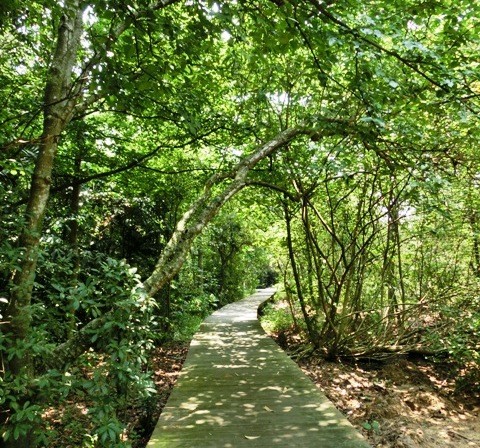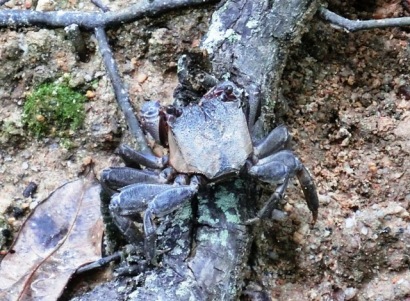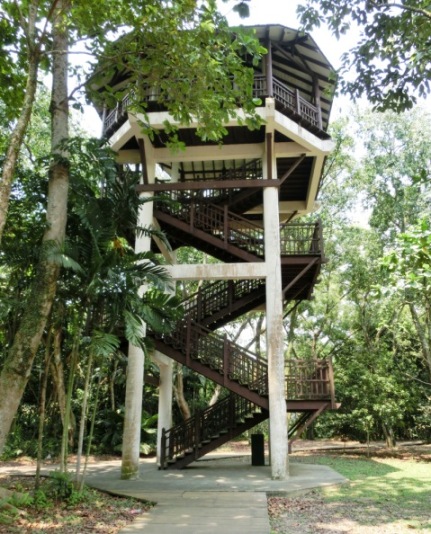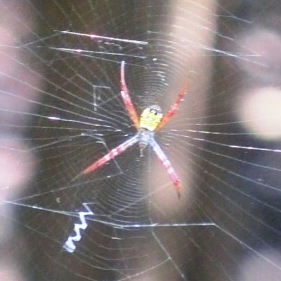Smack in the middle of Pasir Ris Park, mere metres away from the densely populated housing board (Government built high-rise apartments) town of Pasir Ris, lies a … mangrove swamp. A real, live, living and breathing mangrove forest swamp, and an original as well. Who would have thunk it.
 My friend and I stumbled upon the mangrove swamp while exploring the beautifully green and leafy Pasir Ris Park, and were we glad for the interesting discovery. It was almost as if we had walked into a living classroom showcasing one of nature’s ecological marvels.
My friend and I stumbled upon the mangrove swamp while exploring the beautifully green and leafy Pasir Ris Park, and were we glad for the interesting discovery. It was almost as if we had walked into a living classroom showcasing one of nature’s ecological marvels.
THE LOWDOWN
 Mangrove swamps today make up only 0.5% of Singapore’s land area, compared to 13% along the island’s coastal areas in the early 1800s, before the British arrived and when much of Singapore was still a backwater fishing village. Residents in Singapore however would probably be more surprised at the fact that we have any mangrove swamp left at all.
Mangrove swamps today make up only 0.5% of Singapore’s land area, compared to 13% along the island’s coastal areas in the early 1800s, before the British arrived and when much of Singapore was still a backwater fishing village. Residents in Singapore however would probably be more surprised at the fact that we have any mangrove swamp left at all.
The Pasir Ris Mangrove Swamp is one of only two protected mangrove swamps in Singapore, the other being the Sungei Buloh Wetland Reserve. When Pasir Ris Park was built on reclaimed land in the late 1970s, a patch of mature mangrove forest was retained as part of ecological efforts to conserve Singapore’s remaining biodiversity. Mangrove swamp forests are biologically complex ecosystems, an ultimate example of symbiosis in nature with all kinds of creatures co-dependent on the unique biosystem in the swamp.
At 6 ha in total the Pasir Ris Mangrove Swamp is decent-sized, yet still manages to be almost completely hidden inside the sprawling Pasir Ris Park. Once you step onto the boardwalk into the mangrove forest, you leave the park behind and enter a different world. Shady and cool inside, this is the world of strange-looking amphibious trees, and a landscape that is brown, soggy and even Martian-like what with the odd looking volcano-like mounds and large holes puncturing the mud floor.
 It turns out that mangrove swamp trees have “breathing roots” that enable them to survive both on land and in water. These roots may be needle-like roots poking up from the mud, roots that resemble knobbly knees, or roots that look like fingers of a hand cupped and propping the trees up. The roots help the plants to take in oxygen from the air as the dense mangrove mud lacks oxygen. The massive root systems also help in stemming erosion.
It turns out that mangrove swamp trees have “breathing roots” that enable them to survive both on land and in water. These roots may be needle-like roots poking up from the mud, roots that resemble knobbly knees, or roots that look like fingers of a hand cupped and propping the trees up. The roots help the plants to take in oxygen from the air as the dense mangrove mud lacks oxygen. The massive root systems also help in stemming erosion.
 The mud mounds are created by the mud lobster, and the burrows go as deep as 2 metres underground. The mounds are dryer than its surroundings and provide important refuge for other creatures during high tide.
The mud mounds are created by the mud lobster, and the burrows go as deep as 2 metres underground. The mounds are dryer than its surroundings and provide important refuge for other creatures during high tide.
The mangrove swamp is certainly no fairy tale dreamscape swamp where one would be likely to find Shrek (but then again the green ogre probably wasn’t from the tropics). It is however a magnificent habitat, teeming with life, bursting with ecodiversity.
VISITING
The mangrove swamp is ringed by a wooden boardwalk in the centre with 5 “on-ramps” leading to the centre ring. An additional fork in the boardwalk leads off to a small pier overlooking the mangrove-lined Sungei Tampines (Tampines River).
There are quite a few observational points and resting areas, perfect for bird and swamp life watching, and of course you can stop along the boardwalk at any time should something interesting catch your eye, such as the many types of crabs, molluscs – snails, slugs, mussels and oysters, or giant mudskipper fish, which incidentally also climbs trees at night using its fins!
Information panels are plentiful all around the boardwalk, done up in a kid-friendly cartoon style. Very nice and educational, pity the text is riddled with grammatical errors though.
To get a vantage view of the area you can climb up the 3-storey high Bird Watching Tower. The mangrove swamp and the larger Pasir Ris Park are a rich ground for all types of birds – as evidenced by the number of serious birdwatchers we saw in the park with their impressive equipment.
LOCATION
Pasir Ris Park, off Pasir Ris Drive 3
Carpark “C” (turn into Pasir Ris Green) or Carpark “B”
The park and the mangrove swamp area are open 24 hours, however note that the swamp area is not lit. You can visit in the evening to view the beginnings of nocturnal swamp life and activity however I do not suggest you visit when it gets too dark unless you are a real daredevil.
HOW MUCH TIME
About an hour or slightly more to leisurely stroll in the shady and cool confines of the swamp forest, read up on all the interesting facts about the mangrove swamp and to quietly observe the swamp life.
TIDBITS
- There are a few types of crabs that make their home in the Pasir Ris Mangrove Swamp, among them one called the Tree Climbing Crab that can climb to as high as 6m at night to avoid the tide and the predatory creatures that the incoming tide brings. Interestingly, locally they are also called Singapore Vinegar Crabs, as they are tasty with vinegar.
- Some mangrove trees are uniquely viviparious, meaning they are able to reproduce seeds that germinate and grow while still attached to the parent plant. This gives the young seedlings a better chance of surviving in the swamp once they dislodge from the parent plant and are on their own.
- If you detect a smell of rotten eggs, it is not because there is something rotting in the mud. Mangrove mud is rich in sulphur, and as hydrogen sulphide is produced you may think you smell rotten eggs.
- There are 4 species of resident water snakes at the Pasir Ris Mangrove Swamp, including one called the “Dog-faced Water Snake”, named such because of its distinctive head shape and small eyes positioned close to the top of its head which allow it to see above water. It also has valve-like nostrils to shut out water, and “well defined “lips” “.
- The bird Watching Tower is also known by some as “Suicide Tower”, as apparently somebody had committed suicide by jumping down from the tower some years back. Needless to say, the tower is rumoured to be haunted. We noticed red candle wax remnants all the way along the staircase to the top of the tower when we visited, so someone had performed a blessing or ritual of some kind.
TAKE NOTE
- The mangrove swamp is different at low tide vs high tide, with different types of swamp life predominant depending on whether the swamp is dry or flooded. Check the tide schedules before you go.
- The boardwalk is broad enough and the terrain is completely flat making it wheelchair and baby stroller -friendly. No biking is allowed however.
USEFUL LINKS
- NParks (National Parks Board of Singapore) guide to both Pasir Ris Park and the Mangrove Swamp
- NUS (National University of Singapore) field guide book – page on visiting mangrove swamps in Singapore (2001)
- NUS field guide book – page on Pasir Ris Mangrove Swamp
- National Library Board’s Infopedia site on mangroves in Singapore






Have been to the mangrove swampland in Sungei Buloh a few years ago. Really amazing, so excited to go visit this when I have the chance! As for the rotten eggs smell caused by the sulphur, you may grow to like it. Coming from the hot spring town of Beppu, Japan, I must say that I find the sulphuric smell in the “onsens” to be quite soothing!
Hi Monica, the sulphuric smell is no where near how strong it was in Beppu, thank goodness!
Pingback: Pasir Ris Park: One for the Family | UnTourist Singapore
So which tide do you recommend visiting in? High or low?
Hi Tim,
Well I only visited at low tide. The landscape wasn’t pretty as you can see, but I did get to see all kinds of creatures camouflaged among the mudflat. Very interesting.
I have read though that when the water is in you also see other, interesting things. And then of course day vs. night/evening you see different wildlife. So I say just pick a time that suits your schedule, and uhm, go with the flow..
Past participle of think is ‘thought’, not thunk. Just saying. Nice article anyways!
I know I know, but this is more fun…
http://www.urbandictionary.com/define.php?term=Who%20would%27ve%20thunk%3F
And “anyways”….!
Pingback: Sungei Buloh Wetland Reserve: Crocodile Spotting! | UnTourist Singapore